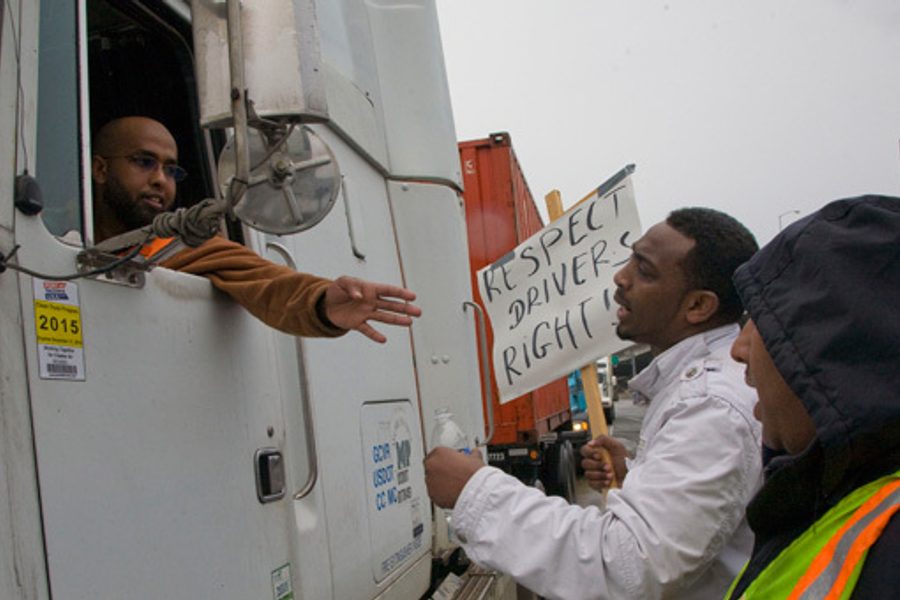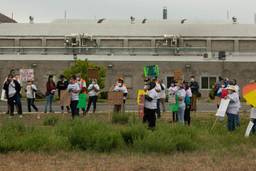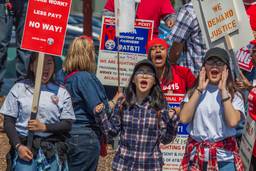Seattle Port Strike Challenges ‘Independent Contractor’ Lie
Truck drivers in the Puget Sound shut down ports for two weeks—and begin to shift the balance of power.
David Bacon

SEATTLE – Employers say they’re “independent contractors.” Drivers call that a legal trick to deny them their rights – a nice-sounding label obscuring an ugly reality.
For two weeks in February, this argument raged at terminal gates in the ports of Seattle and Tacoma. Hundreds of truckers, who normally ferry huge shipping containers from dockside to waiting trains and warehouses, refused to get behind the wheel and drive. Instead, they caravanned to the terminal gates and appealed to their coworkers to climb out of their cabs and join their strike.
Port managers claimed that it was business as usual on the docks. Standing in front of the BNSF rail yard, though, the strikers could see stacks of containers that weren’t going anywhere. When they wouldn’t drive, the “cans,” as they’re called, stacked up on ships, in rail yards, and at warehouses. The port’s lifeblood slowed to a crawl. Cargo has to move for shippers and trucking companies to make money. A still container, a waiting ship and an idle truck all mean lost profits. It was clear the strike was costing employers a lot of money.
Finally, after the standoff had gone on for two weeks, on February 14 the two sides basically declared a truce, and drivers went back to work. In their eyes, however, it was only a step, not yet an agreement that resolved their problems. They had made their point, however, by showing the trucking companies they work for – and the huge shipping corporations behind them – that drivers have power over the movement of cargo. And they could and would use it to bring about the changes they demanded.
The truckers came away from the strike better organized than they’d ever been before. Every morning they’d gather at the Teamsters Union hall in Tukwila before heading to the docks. Then, in the evening they’d return. The hall would fill with drivers in intense conversations in Amharic, Somali, Urdu and English as they repeated their demands and decided on tactics for the following day. After two weeks, a hardened core of 400 were veterans of the flying squads, deployed in winter rainstorms from gate to gate. They had testified in hearings and spoken to reporters.
In the end, many agreed their most important achievement was the organization that emerged strengthened from the strike: the Seattle Port Truckers Association.
Ultimately, the drivers want a change in their status, as does the union helping them, the Teamsters. “We want to be considered employees,” said striker Burhan Abdi, by which he meant that the companies should assume real responsibility for the conditions they impose.
While the containers with the cargo and the trailers that carry them belong to the shipping companies, the tractors – that is, the engines and cabs that pull the trailers – belong to the drivers. In theory. In reality, ownership is a not-so-polite fiction.
To drive for the trucking companies, the workers have to lease them their trucks. “But when I need to use the truck for some other purpose, it’s not mine,” explained Abdi. “It’s the company’s. It looks like I own it, but that’s not real. It’s my truck but it’s not my truck.” Abdi said that if he even used it to move his family’s furniture to a new apartment, the company would fire him for it.
That’s just one reason truckers refused to haul loads for two weeks. Since the deregulation of the trucking industry in the 1970s, the fiction of ownership has been the lever the companies use to dictate conditions and prevent bargaining over them. Trucking companies pay a set amount for each load a driver hauls – usually between $40 and $48. Out of that, drivers have to pay all the costs of running their rigs – the gas, the repairs and maintenance. The trucking companies in turn get paid by the huge corporations that own the ships, railroads, container cranes and terminals.
Drivers often have to wait in long lines to pick up a load. Dozens of cabs and empty trailers stand with their big diesels running. The air turns thick and acrid from their blue smoke. In the distance, huge ships are pulled up next to the docks, containers stacked so high on their decks they seem like tall buildings. Enormous cranes stack and unstack the cans, moving them like toys from dock to ship and back.
One driver described his life: “In order to get a load, you have to get up early, at four o’clock in the morning. You pull yourself up into the cab of your truck while you’re still half-awake – you don’t even see your family before you leave. Then you go down to the harbor and get into the lines. And you wait. Finally, you get to the head of the line, and you get a container. Then you’re on the freeway, making time as fast as you can, to deliver it to the customer. When you get there, you usually have to wait to unload as well, before you go back down to the harbor for another pick up. No one pays you for all those hours of waiting.”
“When we stay at a terminal we don’t get paid,” said another driver, Michael Kidane, who drives for Pacer Cartage. “When we haul heavy loads or reefers (refrigerated containers), we don’t get paid for that. When we return a chassis, we don’t get paid. The company gets paid for all this, but we don’t.”
Often the trailers are in poor condition, and drivers can be cited if their brakes don’t work properly. Cans are stuffed so full they weigh more than the legal limits. Starbucks, for instance, according to drivers, is well known for overweight containers. If they take on the load and later are stopped by the Highway Patrol, they’re fined for excessive weight. Drivers, not companies, have to pay the fines, and if they get too many tickets, they can lose their licenses. But if they refuse the loads, the employers will punish them by denying them work for a few days.
One of the strike’s demands, Kidane noted, was that companies should give them copies of the cargo manifests for the containers. They show how much the cans weigh, and even more important, how much the companies get for hauling them. Unsurprisingly, this was a demand the trucking firms resisted strongly.
‘Babies’ and ‘monkeys’
Companies charge drivers $120 a week for liability insurance, even though the freight is already insured by the shippers. Sometimes a driver gets sick or there’s not enough work, and the rig sits idle. Then drivers get the symbol they detest the most, that more than any other inspired their strike: the negative paycheck. Their employers hand them a check with a $120 charge they’ll deduct from future earnings, for a week when the truck never moved. Drivers doubt that the companies actually spend that $120 on insurance, and instead believe they pocket most of it.
“They are making $120 each week, $480 per month, times 50 trucks,” calculated striker Jaswinder Singh about his own employer. “There they’re ripping off our money. They are robbing us, robbing us.”
Sometimes, drivers said, the companies let them know their position in graphic language. According to Kidane, when truckers ask about the weight of their loads at his company, the dispatcher calls them babies. “I’m 37 years old, and she calls me a baby,” he fumed. “One of my coworkers is over 50, and he’s a baby too. A baby cannot drive a truck. A baby cannot get a license. I should get an award or something, instead of being called a baby.”
In another company, drivers heard themselves referred to on the radio as monkeys. “There are white drivers, black drivers, Indians, Chinese, and Africans. They call all of us a bunch of monkeys,” said Abdulkadir Ali, as he held aloft a sign saying “Respect Drivers’ Rights!”
In every Pacific coast port, most drivers are immigrants. Seattle and Tacoma’s truckers are mostly East African, from Ethiopia, Eritrea, Somalia and Kenya, along with Sikhs from the Punjab region of India. As immigrants, drivers often feel vulnerable. Abdi explained that they have to learn quickly to confront racism in the U.S. in a way they didn’t have to in Africa.
“We are mostly immigrants and mostly blacks,” he said. “I come from Somalia. Nobody even knows the word discrimination back there. But over here, I see discrimination when something wrong is happening. And everything wrong is happening in the Port of Seattle. We may come from countries far away, but we still have rights.”
About 100 Sikhs, who make up 10 percent of the workforce, met at their local church to talk about whether or not to join the strike. “We understand,” Jaswinder Singh recounted, “and we are not scared.” The Sikh’s memory of their own history, he explained, helped them understand the issues in their conflict with the companies. “We come from India, and we fought there against the British and kicked them out. We are fighting for the same thing here – integrity and simple respect and fairness. We believe in democracy, and we will fight peacefully, the right way. But we will fight to the last breath.”
The federal government says harbor truckers, and millions of workers like them, cannot join a union. They may look, think, talk and work like workers, but the government tells them they are not workers at all – they are “independent contractors.”
That status is a product of the deregulation of the trucking industry. In 1973, the federal government began pulling apart the web of rules that had set prices for transporting goods from one point to another, and had provided minimum safety standards for drivers. That process was completed when President Carter signed the Motor Carrier Act of 1980. In the following era of cutthroat competition, trucking companies cut their costs to the bone. The most common method used to pare expenses was getting rid of drivers. Company after company laid off men and women who had been employees for years. Then they offered to pay a driver with his or her own truck a set amount of money to carry a load.
Old-timers remember that the companies had big lots full of used trucks, and sold them to the same people who’d been their employees. Once drivers got loans and bought rigs, though, they drove for the bank. From then on, all the expenses were theirs – gas, insurance, loan payment, repairs – everything.
Federal deregulation of the trucking industry essentially put drivers on a piece rate. For the companies, it was a good deal – they could pay by the load without assuming any of the risks. They no longer had to pay workers compensation, disability or unemployment insurance premiums for the drivers. If taxes or the price of gas went up, drivers had to absorb it. If a truck broke down, it wasn’t the company’s concern.
Freed of these costs, company profits went up. But truckers say as a result, their income dropped. Median income for Seattle drivers is now $28,500 per year, for an average workweek of 60 hours, but strikers on the picket line said they make as little as $15-20,000. Meanwhile, a union hourly wage in the trucking industry can reach $60,000 annually.
West coast preludes
Long before the strike in Seattle, drivers tried to change conditions, especially in North America’s largest port, Los Angeles/Long Beach. In the summer and fall of 1984, drivers unhappy over declining conditions spontaneously struck and shut down the harbor. In the strike’s aftermath, they tried to set up a cooperative, but it failed. After trucking companies refused to improve conditions, drivers struck again in 1988 for six weeks. Rising gas prices led to a national wildcat movement in 1993, as owner-operators refused to pick up loads until trucking companies absorbed part of the increased cost.
On Terminal Island, between San Pedro and Long Beach harbors, police drove strikers from their lines with tear gas and rubber bullets, and forced them back to work. In January 1994, Los Angeles port drivers organized the Latin American Truckers Association, and in 1996 they struck for two weeks with the Communication Workers union. They lost that one as well.
Over the last decade, the Teamsters union, environmentalists and drivers in many ports organized the Coalition for Clean and Safe Ports. Near the Seattle port, in the immediate adjacent neighborhoods of South Park and Georgetown, the EPA has found that cancer risk is 27 times higher than the national average. An estimated 95 percent of the nation’s 110,000 port trucks fail to meet current U.S. EPA emission standards. To reduce the health dangers of the smoke from the long lines of waiting trucks to workers and residents, the coalition has proposed local ordinances. They would make the drivers direct employees of the companies they work for, and set up a dispatch system that wouldn’t require them to wait so long in line for loads.
The trucking companies have challenged all the ordinances and legal battles continue over them. In January in Washington State, the legislature debated a bill that would hold the companies responsible for overweight loads or unsafe trailers, and another that would reinstate the employee status of port truckers. The Washington Trucking Association and the Washington Public Ports Association testified against them both.
The beginning of a new balance of power
When one came up for debate on January 30, however, more than 100 drivers took off work and showed up in Olympia (the capital) to support it. Many of those who testified were threatened. After one driver, Yared Maconnen, was fired at Western Ports Transportation, the other drivers in his company walked off the job. The strike soon spread to other companies. Work stopped at major outfits like Seattle Freight Service Inc., Pacer Cartage, Western Ports Transportation Inc., Edgmon Trucking, Elliott Bay Service Transfer and PCC Logistics. As the strike progressed through demonstrations at the terminal gates and in meetings at the Teamsters Hall in Tukwila, it gave real power to the Seattle Port Truckers Association.
On February 13, drivers and supporters mounted a big rally in the Seattle port. With the help of Local 19 of the International Longshore and Warehouse Union – the workers who run the cranes and load and unload the ships – the drivers met with the port director and representatives of the trucking companies. The following day they agreed to continue talking, a de facto recognition of the power of the truckers’ organization, and drivers went back to work.
As they climbed back into their cabs, some companies offered to increase the price per load by $4 if drivers have to wait more than an hour in line, and to pay for some trips taken without loads. Most of the original demands of the strike are still unresolved, but the balance of power in the port is shifting. Drivers who strike once can obviously do so again.
A similar shift may also be taking place in the tactics of the Teamsters union itself. The effort to win local and state ordinances requiring the companies to restore employee status will undoubtedly continue. But legislative efforts may now be combined with direct pressure in the terminals themselves, by drivers who undertake their own independent action to force immediate changes in conditions.
Seattle and Tacoma are no backwaters. Together they make up the third larges container port in North America, moving 1,700,000 cans a year. What happens on these Northwest docks will be felt in other ports as well, especially if drivers there adopt a similar strategy.
Whether in Seattle, Oakland or Los Angeles, the drivers’ problems are the same. And the companies they “contract” for are too.
“We are considered like containers too, thrown out after we’re used,” Kidane declared bitterly. “But I’m a human being, and I want them to see me and treat me like a human being.”







